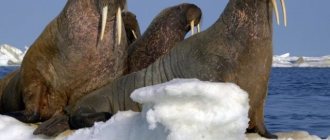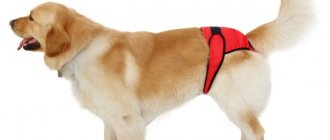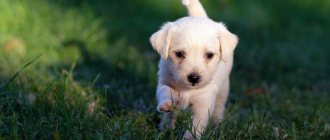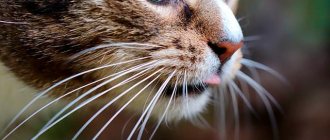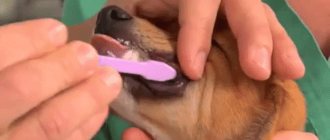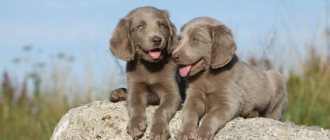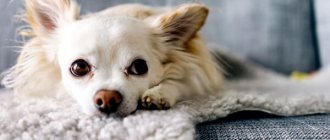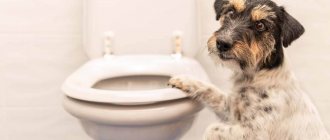Whiskers or vibrissae?
First, let's understand the terminology. After all, the organ that is usually called a dog’s whiskers is actually a whisker. And they have nothing in common with the mustache, except for the approximate location.
They are also not wool, although they look a little similar. A relatively small number of animals have such an organ - dogs, wolves, raccoons, rats, all types of cats and some others.
But still, most dog breeders (especially if we are talking about amateurs and not professionals) the term “vibrissae” is not too familiar. Therefore, we will not use it in the future, returning to a more familiar word. Now we smoothly move on to the next question - why do dogs need mustaches?
Warning
Trimming or removing whiskers is permissible only as prescribed by a veterinarian, but even in this case, the risks must be sensibly assessed. It just so happens that many dogs have their whiskers shortened during grooming, but this is not normal. Most groomers do not see anything wrong with affecting the whiskers, especially if we are talking about a non-working dog. However, orientation in space is important not only in work, but also in everyday life, isn’t it?
How would you react if someone told you that looking with both eyes is ugly? Or would it be prohibited to smell food before consuming it? You think you won't lose anything, but you try and everything will fall into place. Food without flavor seems bland; an incomplete review will drive you to neurosis in 2-3 days. Now imagine how a dog feels when it is almost deprived of tactile sensations.
The first and most harmful consequence is nervousness, a constant feeling of fear and self-doubt. The pet is nervous and stressed for any reason, and stress is the cause of all diseases.
Important! Never cut, pluck or manipulate your dog's whiskers unless these actions are justified! Be sure to consult a doctor, or better yet, several specialists, if the muzzle area is affected by fungi (or other parasites), then try to preserve the whiskers by all available methods
What are they needed for
Alas, science still cannot give a definite answer to this question. Some experts believe that the dog's muzzle is decorated with whiskers in order to provide a tactile sense organ. Indeed, in a state of tension, animals protrude their whiskers, putting them forward and as if feeling a suspicious object or a dangerous enemy. However, for dogs with a keen sense of smell this is simply unnecessary - they already receive all the important information about animals and any things. Well, sticking your nose into a potentially dangerous place to explore it is not the best decision from the point of view of common sense.
Others give a completely different answer when asked why dogs need mustaches. They believe that thanks to this sense organ, animals receive a more holistic picture of the world. For example, they are surprisingly sensitive to the strength and direction of the wind. This already seems to be true. If people receive most of their information through vision, then in dogs the sense of smell comes first. Having the ability to sense smells and at the same time the direction and strength of the wind, they form a much more accurate picture of the world. This is especially important in the wild, for example, when hunting, or vice versa, in the case when a dog or wolf themselves becomes the prey of a more dangerous predator.
In such a situation, the nose together with the mustache allows you to recreate the most accurate picture of the world even in complete darkness, reliably tracking down prey or escaping from a stronger enemy.
Main functions
The main point of why dogs need mustaches was discussed in the previous paragraph. However, vibrissae also perform other functions. In particular these are:
- Helps in identifying odors. The structure of these hairs allows the animal to detect odors at a great distance. Therefore, you can often see your pet standing with its muzzle raised and moving its nose.
- Object location recognition. Helps you better navigate in space, including in the dark. This skill is especially useful for hunting dogs.
- Estimation of wind strength and direction.
Exception breeds
However, there are exceptions to every rule. And when talking about whether a dog can have its whiskers trimmed, you should definitely mention those.
This primarily includes some varieties of poodles and Pekingese. Their whiskers grow almost constantly, while in other dogs, having reached the required length, they stop growing. Moreover, long mustaches don’t just make a dog’s face less attractive. Everything is much worse - in a bent state, they can easily get into the eyes, damage the delicate eyelids, which will lead to inflammation. And this is fraught with serious visual impairment or even complete blindness. So the vibrissae also need some care.
But even in such a situation, you cannot cut them off completely - only shorten them to a safe and comfortable length. It is advisable to have this done by a professional. But as a last resort, you can cope with the task at home - the main thing is that the scissors are comfortable and sharp, and carefully cut off the mustache without tugging at it.
What functions does the mustache perform?
In dogs, the whiskers, or vibrissae, act as a “sixth sense”. The follicles at their base are vascularized, that is, connected to nerve endings that send signals to the animal's brain.
The whiskers protrude from the skin and act as a lever through which the dog receives external stimulus. The information is sent to the follicle and then transmitted to the animal's brain, allowing it to decode the signal and generate a response.
Whiskers in dogs perform the following functions:
- help measure distance in the dark. Air currents perceived by the whiskers give the dog an idea of the size of the room, house, as well as the location of objects in relation to the body.
- read the temperature and wind speed, feeding the information into the dog’s brain.
- vibrissae located above the eyelids work on the principle of eyelashes, that is, they protect the dogs’ eyes from dust and dirt in the air.
Few people know, but a dog’s whiskers are proportional to its body. Thanks to this, the animal is able to predict how wide or narrow the space in front of it is and whether it can pass.
Why do dogs need mustaches?
On the head of dogs and cats there are sensitive hairs located in groups, thicker and longer than the rest of the coat. They are located above the eyes, on the cheeks, on the upper and lower lips, and in dogs also in the corners of the mouth.
Cats have more, so to speak, “powerful” whiskers than dogs, and we are accustomed to the fact that this is an important and integral part of the cat’s body. However, although dogs' whiskers are not as pronounced, they play no less important role in the perception of the world than cats.
Vibrissae are an organ of tactile perception. Due to them, furred animals are sensitive to touch no less, if not more, than we humans. The thicker and longer the hair, the more nerve endings at its base that carry information about the surrounding world to the animal’s brain.
With their help, dogs and cats feel objects, navigate in the dark, and determine the strength and direction of the wind. In other words, vibrissae help them perceive the picture of the world more holistically.
Loss of whiskers in dogs
Periodic whisker loss is as natural as shedding. After reaching its maximum length, the hair ceases to receive the required amount of nutrients, so it becomes thinner and falls out.
In addition to the growth cycle, there are several other reasons for hair loss:
- stuffiness in the living space;
- prolonged exposure to heat;
- dry air;
- frequent washing;
- lack of water in the body;
- hormonal surges characteristic of sexual heat, pregnancy and lactation.
All these problems can be solved with regular ventilation, reducing the duration of walking in the summer, buying a humidifier, reducing the frequency of bathing to 1-2 times a month and monitoring the fluid you drink. The owner's intervention is not required only in the latter case, where whisker loss stops on its own after stabilization of the hormonal levels.
If the above methods do not work, contact your veterinarian. In rare cases, the cause of loss is helminthiasis and disorders of the thyroid gland.
Why do dogs need mustaches?
You've probably noticed inconspicuous whiskers on your dog's cheeks. If cats have this habitual attribute, then why do dogs need mustaches?
All animals have hard hair around the eyes, on the cheeks, chin, the so-called “vibrissae” - sensitive long, hard hair that protrudes significantly above the coat. They have very sensitive bulbs, so with the help of them animals feel the surrounding objects and orient themselves in space. They act like a 6th sense organ, which is difficult to do without.
Causes of mustache loss
- Unbalanced diet.
- Allergies.
- Metabolic disorders.
- Vitamin deficiency and lack of microelements.
Important! The dog should receive raw or boiled cartilage (or pig ears), which is useful for renewing connective tissue. If an animal has problems with teeth, the cartilage is replaced with gelatin.
After excluding typical causes, you need to take a medical history and consult a veterinarian. Loss of whiskers may indicate a number of pathologies:
Is it possible to trim a dog's whiskers?
Dogs vary in coat length and whisker length. In some they are invisible, lost among the main hairline, in others they protrude significantly. Professional dog grooming involves trimming almost the entire coat. Spitz dogs, for example, may have their whiskers cut off during grooming. But isn't this dangerous? Dogs have become so domesticated that they can confidently move around the apartment and know their daily diet very well, so the need for whiskers almost completely disappears. On the street, their sense of smell is enough to explore the world around them. Virbiss bulbs contain many nerve endings. The absence of a mustache can lead to incomplete information entering the brain , the dog will become irritable and even aggressive, and in adulthood this can lead to inhibition of the nervous system. You should especially not trim the whiskers of puppies under 2 months of age. Their nerve endings are just forming, and such manipulation can lead to a serious disorder of the nervous system.
Consequences of whisker trimming in animals
To understand why you shouldn’t resort to trimming your mustache (except for these cases), you should look at the consequences that occur for the animal:
- One or more of the senses disappears. The perception of the world around us completely changes. The pet begins to navigate worse.
- The dog begins to receive significantly less information about the world around him. Because of this, behavior also changes. The pet becomes nervous, irritable and even aggressive.
- Older dogs suffer the most. For older dogs, the sudden loss of whiskers results in a strong blow to the nervous system. This can also affect the physical condition of the pet. Diseases, of course, do not develop, but the dog may refuse food for some time and be lethargic.
Why do cats need whiskers?
Cats' whiskers are much longer, thicker and thicker than dogs' whiskers. You can even see the “eyebrows” above the eyes. Cats are naturally more flexible, they love to climb trees, and they can crawl into a seemingly tiny hole. This is where a mustache comes in handy. They use them as hands, feeling the surrounding space . Some experts believe that the mustache corresponds to the proportions of the body, i.e. the wider the cat, the larger the whiskers. Others claim that cats with poor eyesight have larger whiskers. This is quite logical, because vibrissae help adapt to the environment. Therefore, do not allow your cat to lose its whiskers, for example, when playing with children. After all, little children are so curious that they can cut off a cat’s whiskers. Lost mustache - lost orientation in space.
All pets have very sensitive fur; they can feel a light touch even in their sleep. And the mustache is a bundle of nerves, another sensory organ. This part of the body is vital for all four-legged animals.
Sources:
https://fb.ru/article/403991/zachem-sobakam-usyi-i-mojno-li-ih-postrigat https://zen.yandex.ru/media/id/5c59e42abf9a4700b0f74fec/5d383b95c0dcf200ad8e3260 https://puffy- shop.ru/blog/entry/370-zachem-sobakam-usy
Can my pet's nails be trimmed?
Some owners, when getting a dog, are not even interested in how to properly care for it, and then various problems arise with the pet’s health. For example, many people do not know whether it is possible to trim a dog’s mustache, or whether it is possible to trim the nails of a domestic dog. This all relates to important points that the owner must know and follow. After all, how the pet will feel and look depends only on the owner. This is especially true for decorative small breeds that do not know how to take care of themselves and cannot do without human help. Therefore, we will consider in detail whether it is possible to trim the claws of a domestic dog, why this is necessary, what will happen if you leave overgrown claws, and how to trim claws at home.
Why does a dog need nail trimming?
One of the reasons why it is necessary to give a dog a pedicure is that the dog, unlike a cat, does not have the ability to grind on its own, for example, on furniture, carpet or other special surface. The pet is deprived of natural grinding, since it does not lead an active lifestyle, like street stray dogs. Animals that are constantly outdoors have their claws worn down on the asphalt, so they do not cause much harm. It is unlikely that there will be an owner who will run all day long with his four-legged friend on a hard surface. Even if you walk your dog often and for a long time, this will not help, since most likely these walks will be in parks where there is soft ground with grass.
But still, why is it so necessary to trim your dog’s nails? The problem is that long claws interfere with movement and negatively affect the dog’s gait. He cannot place his paw correctly, begins to experience pain when walking, and lameness appears. After some time, the joints of the paws acquire curvature, which will provoke diseases of the musculoskeletal system. And if the musculoskeletal system stops functioning correctly, therefore, paralysis of the limbs occurs. This is just one consequence of uncut nails; various other diseases, in most cases infectious, may also appear. Therefore, in order to avoid such terrible problems, you just need to regularly trim your dogs’ nails.
How often should a dog's nails be trimmed?
The duration of the procedure depends on the size of the breed. Control the length of your pet’s nails; to do this, you should carefully examine your dog’s paws. In small breeds they grow very quickly, but are deprived of natural wear, since they do not lead an active lifestyle, have little weight, and are often carried in the arms. Therefore, they need to have their nails trimmed once every two weeks. Representatives of large breeds have claws that grow more slowly, so they do not need pedicures often. It is advisable to carry it out once a month, and sometimes every two months is sufficient. But still don’t forget to inspect the paws. When moving, the dog makes a clicking sound and often bites its nails, which means it’s time to take up the instrument.
Consequences of neglecting nail trimming
In order for your four-legged friend to be healthy and able to run on the green grass, you need to monitor and care for him. Healthy, strong paws can only be with trimmed claws, otherwise the gait will be crooked and it will be impossible to stand the limbs straight. Let's look at the consequences of ignoring the process:
- Of course, the most important and important problem is the deformation of the limbs, which will lead to diseases of the spine.
- The dog will limp all the time and at the same time feel pain.
- The keratinized nail tissue will dig into the soft skin, injuring it. Therefore, there is a high probability of infection and then inflammation of the paws.
- On the dewclaws, which are higher than the rest, strongly overgrown claws can catch on some object, causing great injury.
- Long claws are dangerous because when scratching, for example, an ear or eye, a dog can harm itself. If injured, dirty paws will cause infection and further inflammation.
- If there are small children in the house, then the pet can scratch their delicate skin, again the possibility of infection.
- Over time, the nail will grow into the pad of the finger. Then you will have to go to the veterinarian, only he will be able to perform an operation to remove it.
- Damage to property and upholstered furniture has also not been canceled. Your friend will suffer from pain if the tip of the claw gets caught on the sofa and breaks off.
Features of the coat of some dogs
There are a lot of types of fur on dogs, but they are all divided into 2 categories - those that have an undercoat and those that do not. When it comes to haircuts, this division is very important, determining the further course of events. After determining the type of coat, the owner will be able to understand whether his pet can have a small haircut or whether it is worth refraining from the fashion trend.
Hygienic grooming is carried out periodically for dog breeds that do not have a thick undercoat. In addition, the fur of such dogs grows back quite quickly. For long-haired dogs without undercoat, grooming is one of the parts of general pet care.
A timely haircut from a master groomer makes it possible to get rid of matted fur, preventing the appearance of serious tangles, inflammatory processes on the skin and dangerous diseases of the skin itself.
Regularly shortening the coat helps protect the animal from blood-sucking parasites, such as ixodid ticks. The following dog breeds can be groomed:
- Maltese;
- bichon frize;
- poodle;
- Shih Tzu;
- Irish Spaniel.
The above dog breeds require careful handling of their fur. They need to not only be trimmed, but also combed regularly. When hygienically trimming overgrown fur, it is not recommended to use a clipper. Otherwise, the risk of developing skin diseases due to negative environmental influences cannot be excluded.
If the haircut was done with a clipper, it is important to ensure that the dog is not exposed to sunlight. Otherwise, the development of dermatosis, which often turns into a malignant disease - skin cancer, cannot be ruled out.
One of the reasons why you shouldn't clip any dog's hair is vulnerability. The skin, not protected by fur, becomes a target for blood-sucking insects - mosquitoes and horseflies.
